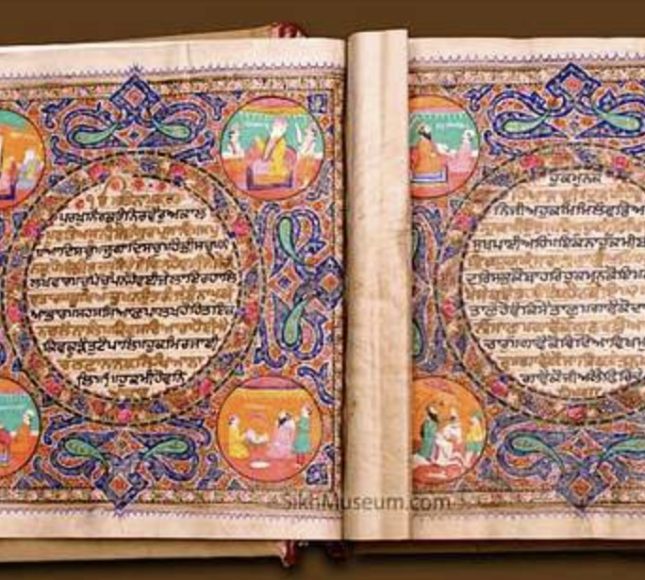SRI GURU GRANTH PRAYAY, a glossary of the Guru Granth Sahib, is an anonymous and undated manuscript preserved in the Khalsa College at Amritsar under catalogue No. 1473. It comprises 147 folios, 24 cms x 16 cms, with 21 lines to a page, and is possibly a late eighteenth century or early nineteenth century work. Although the word prayay would signify /1 a glossary or lexicon, this work is not a | dictionary in the strict sense of the term, for it | lacks the alphabetical order and attempts | neither etymology nor uncovering varying shades of meanings of the words. Words chosen for explanation are in fact listed in the order in which they occur in the text.
For instance, the first entry in Prayay is on “Satinam Karta Purakh” which words figure in the very first line of the first composition, Japu, in the Guru Granth Sahib. Then follow words and phrases picked from succeeding lines or stanzas. Meanings given are those applicable to the textual use of the words. It is but rarely that an alternative meaning has been recorded.
On the back side of folio 147 are mentioned the names of scholars whose works the author had studied. Among them : Bhai Man! Singh, Surat Singh, Gurdas Singh, Santa Singh, Amar Singh, Bhai Chanda Singh, and Bhai Sant Singh. The last two unnumbered pages contain the mythologically accepted divisions of time and their duration.
References :
1. Kirpal Singh, A Catalogue of Punjabi and Urdu Manuscripts. Amritsar, 1962
Sri Guru Granth Prayay, a unique manuscript that functions as a glossary for the Guru Granth Sahib, offering insights into how words and phrases are contextually explained for deeper understanding.
Nature and Structure of the Manuscript
Sri Guru Granth Prayay is an anonymous, undated glossary preserved at the Khalsa College in Amritsar (catalogue No. 1473). Physically, the manuscript comprises 147 folios measuring approximately 24 cm x 16 cm, with 21 lines on each page. While the term “prayay” generally denotes a glossary or lexicon, this work diverges from what one might expect of a conventional dictionary. Rather than being arranged alphabetically or attempting exhaustive etymology, the entries are listed according to their sequential occurrence in the text of the Guru Granth Sahib.
For example, the very first entry deals with the phrase “Satinam Karta Purakh” — a set of words integral to the opening composition, the Japu Sahib, in the Guru Granth Sahib. Following this, the glossary continues by selecting words and phrases from successive lines or stanzas. The explanations provided focus on the meaning these terms have within their specific textual contexts, a method that underscores the importance of understanding language as it functions in sacred scripture.
Scholarly Implications and Methodology
This manuscript exemplifies a contextual approach to linguistics within the Sikh tradition. Key aspects include:
- Contextual Arrangement:
Unlike modern dictionaries that list entries alphabetically, Sri Guru Granth Prayay arranges its entries in the order they appear in the Guru Granth Sahib. This method emphasizes the sequential and interrelated nature of the sacred text, suggesting that comprehension should evolve as one progresses through the scripture. - Focused Meanings:
Rather than delving into multiple or alternative meanings, the glossary largely offers clarifications that are immediately applicable to the usage of the words as found in the scripture. This choice reinforces the idea that the divine words of the Guru Granth Sahib are singular in their function and that their interpretations are deeply rooted in the holistic context of the text. - Intertextual References:
On the verso of folio 147, the manuscript records the names of several scholars whose works have informed the author’s choices. Moreover, the final unnumbered pages discuss mythologically accepted divisions of time and their duration, indicating that the compiler not only engaged with the linguistic aspects of the text but also with broader cosmological themes in Sikh thought.
The work is thought to date from the late eighteenth or early nineteenth century, a period marked by an evolving approach to textual interpretation and a growing interest in codifying the meanings of Sikh scripture for both devotional and scholarly purposes.
Significance in Sikh Literary Tradition
Sri Guru Granth Prayay holds considerable value for several reasons:
- Bridging Oral and Written Traditions:
The text is a prime example of how oral traditions of explanation were captured in manuscript form, serving as a guide for those seeking to understand the layered meanings of the Guru Granth Sahib. Its structure reflects a transitional period in Sikh literary culture, where oral recollections and written scholarship began to intersect. - Aid to Devotional Recitation and Study:
For students and devotees alike, the glossary provides clarity on verses that might otherwise be obscure because of their layered, poetic, and sometimes context-specific vocabulary. This contextual understanding is essential for a faithful recitation and deeper spiritual meditation on the scripture. - Historical Linguistic Insights:
Since the glossary does not follow modern lexicographical methods (such as strict alphabetical order), it offers scholars a glimpse into historical methods of textual exegesis. In doing so, it enriches our understanding of how sacred language was treated in a period when the emphasis was less on exhaustive definition and more on capturing the immediate, lived meaning within a religious framework.



